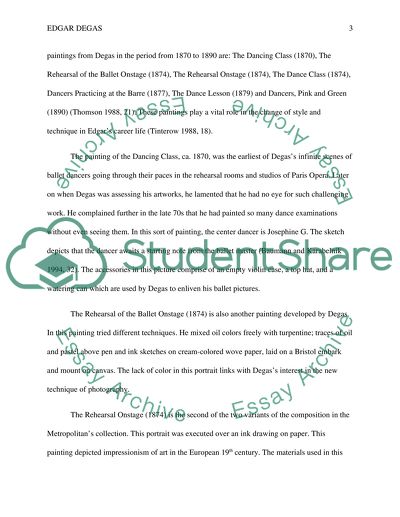Cite this document
(“Edgar Degas and Ballet: how style and technique changed in his art in Research Paper”, n.d.)
Retrieved de https://studentshare.org/visual-arts-film-studies/1593487-edgar-degas-and-ballet-how-style-and-technique-changed-in-his-art-in-the-period-from-1870-to-1890-why-did-it-change-and-how-edgar-degas-influenced-his-art-in-the-given-period-of-time-and-how-his-art-influenced-edgar-degas
Retrieved de https://studentshare.org/visual-arts-film-studies/1593487-edgar-degas-and-ballet-how-style-and-technique-changed-in-his-art-in-the-period-from-1870-to-1890-why-did-it-change-and-how-edgar-degas-influenced-his-art-in-the-given-period-of-time-and-how-his-art-influenced-edgar-degas
(Edgar Degas and Ballet: How Style and Technique Changed in His Art in Research Paper)
https://studentshare.org/visual-arts-film-studies/1593487-edgar-degas-and-ballet-how-style-and-technique-changed-in-his-art-in-the-period-from-1870-to-1890-why-did-it-change-and-how-edgar-degas-influenced-his-art-in-the-given-period-of-time-and-how-his-art-influenced-edgar-degas.
https://studentshare.org/visual-arts-film-studies/1593487-edgar-degas-and-ballet-how-style-and-technique-changed-in-his-art-in-the-period-from-1870-to-1890-why-did-it-change-and-how-edgar-degas-influenced-his-art-in-the-given-period-of-time-and-how-his-art-influenced-edgar-degas.
“Edgar Degas and Ballet: How Style and Technique Changed in His Art in Research Paper”, n.d. https://studentshare.org/visual-arts-film-studies/1593487-edgar-degas-and-ballet-how-style-and-technique-changed-in-his-art-in-the-period-from-1870-to-1890-why-did-it-change-and-how-edgar-degas-influenced-his-art-in-the-given-period-of-time-and-how-his-art-influenced-edgar-degas.


